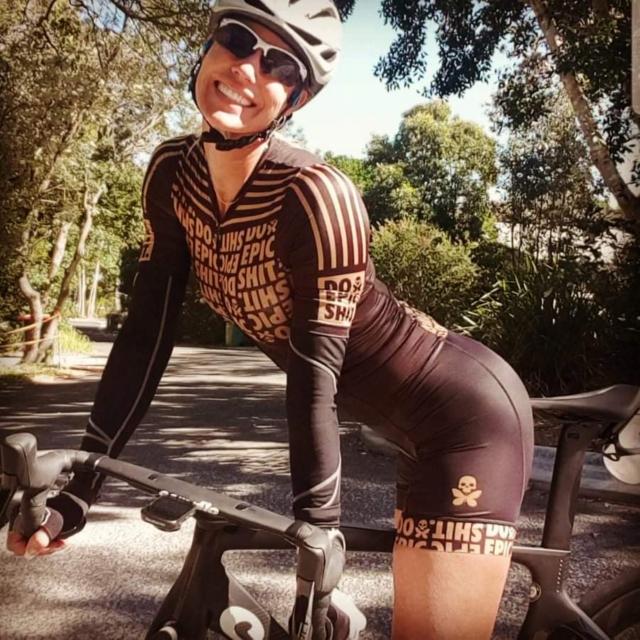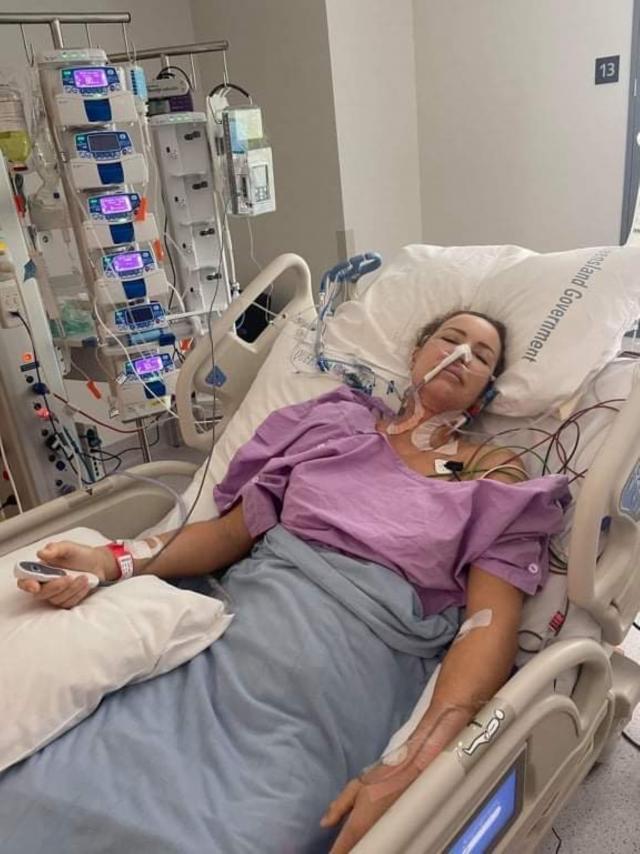
Ingi Doyle lived in Rainbow Beach for four years from 2016 until 2020 and competed in triathlons across the country before she and partner Scott Elms moved to Birtinya on the Sunshine Coast.
It was a fortuitous move, as one of the fittest women on the circuit, this 53-year-old superfit mother who prided herself on her dedication to sport and thrived on her credibility as a triathlete had a reaction to her second Covid-19 injection and has been in hospital on and off since.
Ingi received her first Pfizer injection on 12 June 2021 and the second on 4 July 2021. From the moment she received the second vaccination she said she immediately lacked aerobic energy and on 18 July 2021, 14 days later, Ingi first presented to emergency.
Ingi suddenly felt a sharp pain in her lower abdomen and lower back. It was getting worse near midnight, so she went to emergency.
It was during the Covid lockdown, and she was greeted by a team of doctors at the emergency department who introduced themselves and told her she had a dissected aorta.
“My husband Scott was not allowed to come in with me due to Covid. I was quickly attended to and assessed, sent off for a scan.
“A dissected aorta sounded to me like a death sentence. I was again sent off for a different scan, so they could pick up more details.
“It was confirmed, I had a dissected aorta from below the renal arteries, down to the iliac branch.
“Later that morning, I was sent to a ward where I had a lot of tests as they were looking for a cause and signs of disease.“
Ingi was started on blood pressure, stroke, cholesterol, blood thinning, painkillers, and nausea medications and she learnt that there was no obvious reason why this had happened to her.
“I had them all puzzled how someone at my age, so fit and healthy, living a fitness and health-based lifestyle, would be struck by this.
“I also learnt that they found a condition called Fibro Muscular Dysplasia (FMD), in my posterior neck arteries. This is a condition I had never heard of, but they said, it is likely I have had it all my life.
“They found a small dissection on my left side, but I was told it was unrelated as it looked all healed over and old. Of course, they looked high and low for other signs of FMD in all the common places but found none.”
After an additional few nights on the ward, Ingi was sent home to manage her new condition with medication as well as strict instructions not to elevate her heart rate or blood pressure.
After two weeks at home adjusting to a very slow way of living, Ingi got a phone call asking her to come straight back to emergency.
This time she was sent to ICU.
“Again, the various teams of doctors were rotating fast, explaining that I had a hematoma developed above my dissection, getting very close to the renal arteries.
“They were getting ready for surgery. I was about to get a new piece of aorta with new arteries to my kidneys. I had a massive graft, and it was a huge surgery, that left me with a nasty scar and a pressure sore on my backside.”
Ingi said the next week could only be described as a living hell. She has vivid memories of being in ICU, feeling sick all the time, not eating, and hooked to tubes of food. Her kidneys, bowel and liver had stopped working during surgery as the blood supply was cut for some time.
“The risk of living without kidney function and/or bowel function forever was an ever-present, terrifying reality and the heavy drugs I was given made me hallucinate badly and I lost time and days.”
“Several times I just felt like I just couldn’t go on and asking the doctors if I was going to die was commonplace in my new hell. I was being rolled from side to side to stay off my pressure sore.
“My kidneys were hooked up to dialysis. I was trying different drugs for pain to get away from hallucinations.
“At the end of my ICU stay I was allowed to drink and eat liquids. This proved to be a real struggle as my stomach would not accept much.
“I also had the misfortune of experiencing two vasovagal attacks, fainting, and leaving me unconscious for a short while. “
After successfully getting on the walking frame with the physios and moving slowly up the corridor it was decided Ingi was ready to go to a ward after two weeks in ICU.
She said the surgery had been a success and her failing kidneys were nursed back slowly with regular dialysis.
Her liver function improved and continuous blood tests and reassuring scans over the next week made her feel positive.
“My weight had now started to plummet, and I was feeling weak rather than sore. The nutritionist team, that is still supporting me, kept a close eye on me.
“Short walks up and down the corridor, plus trying to get as much food into me as possible, became my daily routine.
“The one thing I couldn’t shake was the constant nausea and an oversized belly. My abdomen was huge, pushed out like a tight drum with skin ready to pop.
“The renal team kept trying to get fluid off me, but all it did at the end was dehydrate me without moving the fluid off my belly.
“Fourteen litres had been removed from me, but my belly persisted and wouldn’t budge. “
After eight nights, Ingi was told she was well enough to go home. She still couldn’t eat very much, and the constant nausea was still there, and she had crippling neck pain which developed after they removed the final central line coming out of her neck. It was replaced with one that was put in for dialysis use only.
Once home, Ingi had to continue dialysis as an outpatient, three times over the next week, five hours each visit.
“At my first follow up, my neck was really playing up. It had the doctors concerned and I was called into emergency that same night for an emergency scan. This time my arrival was expected, I did not have to wait even for one minute.
“All my details were on their screens ready to go. Within minutes, I was hooked up to machines, blood taken and rushed into the CT scan. As my kidneys were only just starting back, I had to sign a special permission slip to be able to have the dye. They weighed up the risks and benefits and deemed it worthwhile.
“This gave us both a big fright, as the last thing we could cope with right now, was another setback. In true VIP style, the results were interpreted very quickly, and I was declared safe and stable. No further issues at all!
“Over the next few days at home, my belly did not get any smaller, and the renal team was getting more and more concerned. The great part was that my kidneys had kicked in more and more and the decision to stop the dialysis for a week as a trial, was made.”
After only a few days off dialysis, a young doctor decided to investigate her belly further. After more scans and x -rays she was off to see the liver specialist and it was decided that her belly was full of fluid caused by a leak from her lymphatic system, so she was called back into hospital for another vacation.
“This time, they put a drain in my waistline, guided by ultrasound. After six hours, three full bags of chyle, had poured out of me: 14 litres, just from my belly.
“I can’t describe how amazing it felt to lose all that pressure on my organs, ribcage, and spine. I felt like I was melting away. I learnt that chyle is made in the lymphatic system every time you eat fat, and its purpose is to move the fat away.”
“As it turns out, my lymphatic system was damaged during surgery, and a small leak had caused my belly to fill up.
“Each time I ate something with fat in it, it would leak into my belly. The best cure for this is to be on a no-fat-diet, to allow the leak to heal naturally.
“I was again getting advice from the nutritionists. By now, my weight was 53-54 kg. I had lost so much weight. A no-fat-diet just seemed absurd as I already looked and felt completely underweight.”
After four more nights on the ward, Ingi was again sent home with strict diet instructions and follow up appointments booked. She said sticking to this diet was incredibly difficult, but the good part was that her nausea finally subsided, but the neck pain still made her head fuzzy and kept her up at night.
The following week she had a follow up appointment with the liver specialist. It was decided she start reintroducing fats into her diet, while keeping a close eye on her belly.
This is where Ingi is now, nearly two years later, and she said at the moment it all seems OK.
“I feel like I have turned a corner and finally have a little more energy. I have started to do some short walks around our lake. I have even been out of the house for a couple of short trips.
“I still have a very long way to go. Each day, as the day progresses, I get tired, and my stomach is bloated and unsettled.
“As my haemoglobin is low, I need to inject myself once a week to boost it. This is a job for Scott, as there is no way I could do that myself. It is only for a few weeks, until things go back to normal.“
Ingi said overall she was progressing in the right direction and she and Scott were hoping for smooth sailing from here. She has follow-ups and ongoing treatments for her neck, which is improving.
“My now, very thin body is all about getting more energy onboard so I can start rebuilding.
“Today, as I walked around the lake, I listened to my running music. It was emotional and uplifting at the same time. As I glance at my shadow and see this stick-like silhouette, I tear up. But I am determined, no matter how long it takes, to get back.
“I look well again, but what you can’t see is that I still have ongoing follow ups, scans, and blood tests. I must check my blood pressure regularly and I am still on medications.
“My kidneys are only at 28 per cent and it looks like they will stay there.
“I have to live with the graft forever and have been told not to exercise at higher levels which means my lifestyle and living has changed forever.
“I get tired very easily and I have some weird pains in my hands and feet, still to be investigated and I am trying to find a ‘new me’.“







